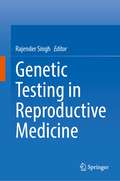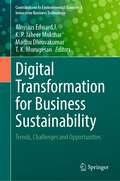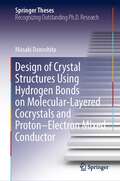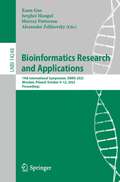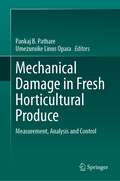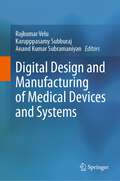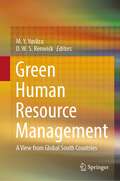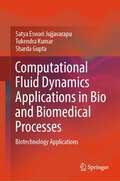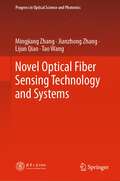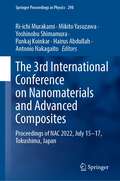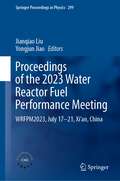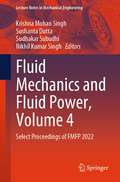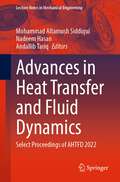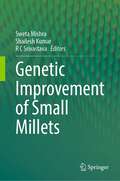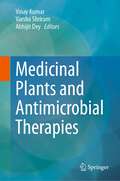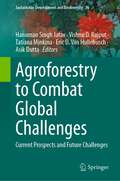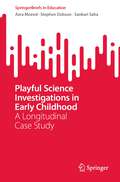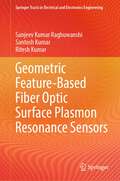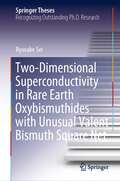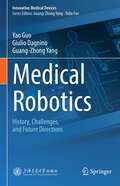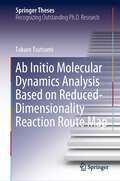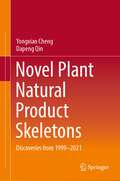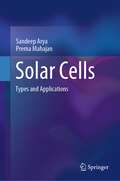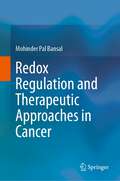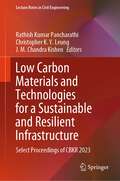- Table View
- List View
Genetic Testing in Reproductive Medicine
by Rajender SinghThis textbook illustrates the importance and significance of molecular genetic testing in reproductive disorders. The present book covers the genetic testing in various reproductive system anomalies, including disorders of sexual development, male infertility (Y deletions, autosomal mutations, sperm DNA fragmentation), female infertility (PCOS and POF), mitochondrial DNA testing for oocyte quality, recurrent pregnancy loss, pre-term birth, endometrial receptivity, prenatal genetic screening, reproductive carrier screening, preimplantation genetic screening, endometrial cancer, cervical cancer and other related reproductive health disorders. Microbiome testing and its contribution to genetic testing in reproductive medicine are also discussed. Genetic testing in some of these has already come into practice, genetic testing for others is established but not clinically practiced, and genetic testing for others is yet in infancy as there is only limited data available. For the disorderswhere sufficient genetic data to undertake genetic testing is not available, we have tried to put together the evidence for proposing such tests in the near future. Apart from this, the book also covers ethical, moral and technical challenges in genetic testing in reproductive medicine. The book aims to set up a standard with regard to genetic testing in the reproductive medicine field, encourage further data generation, and provide food for thought in the areas of lacunae. The book serves graduate students, researchers, clinicians, professors, and patients in the field of reproductive medicine.
Digital Transformation for Business Sustainability: Trends, Challenges and Opportunities (Contributions to Environmental Sciences & Innovative Business Technology)
by Aloysius Edward J. K. P. Jaheer Mukthar Madhu Dhruvakumar T. K. MurugesanThis book explores how digital technologies can be used to drive sustainable business practices and achieve long-term business success. It offers insights and practical strategies and guidance that can help businesses adapt to the digital age, optimize their operations, and create new opportunities for growth. The book further provides real-world examples that illustrate how businesses can leverage digital technologies to achieve long-term sustainability and success. The book is an essential read for business leaders, managers, academician, practitioners and entrepreneurs who are looking to drive sustainable digital transformation within their organizations. The book covers a wide range of topics, including:1) Understanding the digital landscape: The book provides an overview of the digital technologies that are transforming business operations, such as artificial intelligence, cloud computing, and the Internet of Things. It explores how these technologies can be leveraged to create sustainable business practices that benefit both the organization and society.2) Building a digital strategy for sustainability: The book offers guidance on how businesses can develop a digital strategy that aligns with their sustainability goals. It covers topics such as identifying digital opportunities, setting targets, and measuring performance.3) Embedding sustainability into digital operations: The book explores how businesses can integrate sustainability into their digital operations, such as data management, supply chain management, and product design. It provides examples of companies that have successfully implemented sustainable digital practices.4) Digital innovation for sustainability: The book discusses how businesses can use digital innovation to create new opportunities for sustainability. It covers topics such as circular economy business models, sustainable product design, and social innovation.5) Leading for sustainable digital transformation: The book offers insights on how business leaders can drive sustainable digital transformation within their organizations. It covers topics such as leadership skills, organizational culture, and stakeholder engagement.
Design of Crystal Structures Using Hydrogen Bonds on Molecular-Layered Cocrystals and Proton–Electron Mixed Conductor (Springer Theses)
by Masaki DonoshitaThis thesis addresses the design of crystal structures using hydrogen bonds. In particular, it focuses on the design of functionalities and the control over the packing of molecular assemblies, based on molecular designs.Firstly, the synthesis and evaluation of a proton–electron mixed conducting charge transfer salt is reported. Focusing on the difference in the strength of hydrogen bonds and weaker intermolecular interactions, a system was rationally designed and constructed where electron-conducting molecular wires were encapsulated within a proton-conducting matrix. Next, the investigation of structural phase transitions in a cocrystal consisting of hydrogen-bonded two-dimensional molecular assemblies is reported. Drastic rearrangements of hydrogen-bonded molecular assemblies in the cocrystal led to single-crystal-to-single-crystal phase transitions, resulting in anisotropic changes in the crystal shape. Furthermore, chemical modification of a component molecule in the cocrystal is reported. The modification afforded control over the stacking patterns of the two-dimensional molecular assemblies, i.e., sheets, and the mechanism was discussed considering the intersheet intermolecular interactions and molecular motion.It is suggested that hydrogen bonds are beneficial to construct molecular assemblies in molecular crystals because of their strength and well-defined directionality, and the consideration of coexisting weaker intermolecular interactions can lead to the design of whole crystal structures and, hence, functionalities. This thesis benefits students and researchers working on solid-state chemistry by presenting various methods for characterizing and evaluating the properties of molecular solids.
Bioinformatics Research and Applications: 19th International Symposium, ISBRA 2023, Wrocław, Poland, October 9–12, 2023, Proceedings (Lecture Notes in Computer Science #14248)
by Xuan Guo Serghei Mangul Murray Patterson Alexander ZelikovskyThis book constitutes the refereed proceedings of the 19th International Symposium on Bioinformatics Research and Applications, ISBRA 2023, held in Wrocław, Poland, during October 9–12, 2023.The 28 full papers and 16 short papers included in this book were carefully reviewed and selected from 89 submissions. They were organized in topical sections as follows: reconciling inconsistent molecular structures from biochemical databases; radiology report generation via visual recalibration and context gating-aware; sequence-based nanobody-antigen binding prediction; and hist2Vec: kernel-based embeddings for biological sequence classification.
Mechanical Damage in Fresh Horticultural Produce: Measurement, Analysis and Control
by Pankaj B. Pathare Umezuruike Linus OparaThis book includes the impact, compression, vibration studies, and destructive and nondestructive techniques for bruise measurement. It is essential to detect bruises in the early stages of their formation and conduct a quantitative analysis of the degree of bruising, to ensure the accurate grading of bruised fruits and vegetables and reduce unnecessary economic losses. Bruise damage occurring between the point of harvest and consumption contributes the most to the decrease in fruit quality, reducing the market value and ultimately leading to significant reductions in potential revenue. SDG 12.3 aims to “by 2030, halve per capita global food waste at the retail and consumer levels and reduce food losses along production and supply chains, including post-harvest losses.” This book presents recent technological developments in bruise measurement, detection, and analysis of fresh horticultural produce. Given the rising demand for rapid and accurate methods of quality measurement in the horticultural produce industry, this book covers destructive and nondestructive techniques for bruise measurement. Selected applications of different nondestructive methods for various fresh produce commodities are also included. This book will interest graduate and undergraduate students, researchers, academics and engineers working in different aspects of the mechanical damage affected by postharvest handling practices, professionals working in the governments, and other authorities related to fresh horticultural produce quality, regulations, and safety.
Digital Design and Manufacturing of Medical Devices and Systems
by Rajkumar Velu Karupppasamy Subburaj Anand Kumar SubramaniyanThis book coherently presents the advances in technological principles, processes, and methods of Additive Manufacturing (AM), Augmented reality (AR), and Internet of things (IoT) in biomedical technology. It offers an overview of these high-impact technologies in terms of materials, processes, and in-situ monitoring of fabricating biomedical devices, implants, and prosthetics. Furthermore, the book also aimed to cover pedagogical applications, including the design and development of high-fidelity anatomical and hybrid physiological human models, for medical and design students and clinicians for learning, understanding, and gaining insights into the structures and functions of human organs and pathology. In turn, the book also discusses the applications of artificial intelligence in the 3-D printing of pharmaceuticals. This book is a useful resource for manufacturers, scientists, engineers, and young research scholars understand disruptive technology's real potential in biomedicalapplications.
Green Human Resource Management: A View from Global South Countries
by M. Y. Yusliza D. W. S. RenwickThis book offers a fresh perspective on Green Human Resource Management (Green HRM) by focusing on the Global South's industries and cultures. It takes a scientific approach, using evidence to show how sustainable practices in HR can promote environmental goals. The book contributes significantly to the understanding of both the theory and real-world impact of Green HRM. The book offers a wealth of information on various approaches making it not only an intriguing read but also an informative and insightful reference for Green HRM experts all over the world.
Computational Fluid Dynamics Applications in Bio and Biomedical Processes: Biotechnology Applications
by Satya Eswari Jujjavarapu Tukendra Kumar Sharda GuptaThis book covers emerging areas in novel design and their hydrodynamic properties relevant to bioreactors, environmental system, electrochemical systems, food processing and biomedical engineering. This book uses an interdisciplinary approach to provide a comprehensive prospective simulation modeling and hydrodynamic study in advanced biotechnological process and includes reviews of the most recent state of art in modeling and simulation of flows in biological process, such as CFD. Written by internationally recognized researchers in the field, each chapter provides a strong introductory section that is useful to both readers currently in the field and readers interested in learning more about these areas.
Novel Optical Fiber Sensing Technology and Systems (Progress in Optical Science and Photonics #28)
by Mingjiang Zhang Jianzhong Zhang Lijun Qiao Tao WangThis book highlights recent advances in novel optical fiber sensing technology and systems, using distributed fiber sensing technology based on chaotic lasers. Upon introducing the basic theory of chaotic laser, a novel light source, the book summarizes new frontier technologies, and presents photonic integration and sensing applications. The book elaborates on new technologies of distributed optical fiber sensors and its engineering applications, as well as narrow-linewidth fiber laser for optical fiber sensing. This book is of great reference for researchers and professionals in the area of optics and optoelectronics.
The 3rd International Conference on Nanomaterials and Advanced Composites: Proceedings of NAC 2022, July 15-17, Tokushima, Japan (Springer Proceedings in Physics #298)
by Ri-Ichi Murakami Mikito Yasuzawa Yoshinobu Shimamura Pankaj Koinkar Hairus Abdullah Antonio NakagaitoThis book presents selected articles from the 3rd International Conference on Nanomaterials and Advanced Composites (NAC 2022) held at Tokushima University in Japan. This event brought together leading researchers and professionals from academia and industry to present their latest findings and served as a platform for the exchange of ideas aiming for further collaborations. Participants from over six countries shared their most up-to-date knowledge in their respective fields covering nanotechnology, nanomaterials, and advanced composites. Even though this conference had both on-site and remotely connected attendees, the main purpose to promote the networking among academics, engineers, and students was fully achieved. This book is part of the effort to disseminate the knowledge gathered during this meeting. The collection of articles covers topics on advanced composites, nanomaterials, ecological materials, energy, microfluidics, crystal growth, and photocatalysis. This representative account of the conference is intended to provide new and useful insights for prospective studies in materials science and engineering.
Proceedings of the 2023 Water Reactor Fuel Performance Meeting: WRFPM2023, July 17–21, Xi’an, China (Springer Proceedings in Physics #299)
by Jianqiao Liu Yongjun JiaoThe Water Reactor Fuel Performance Meeting (WRFPM) held in Asia has merged with TopFuel in Europe and LWR Fuel Performance in the United States to form the globally most influential conference in the field of nuclear fuel research. WRFPM2023 is organized by Chinese Nuclear Society (CNS) in cooperation with the Atomic Energy Society of Japan (AESJ), Korean Nuclear Society (KNS), European Nuclear Society (ENS), American Nuclear Society (ANS), the Interna-tional Atomic Energy Agency (IAEA) with the support from China Nuclear Energy In¬dustry Corporation (CNEIC) and TVEL.Conference Topics:1. Advances in water reactor fuel technology and testing2. Operation and experience3. Transient and off-normal fuel behaviour and safety related issues4. Fuel cycle, used fuel storage and transportation5. Innovative fuel and related issues6. Fuel modelling, analysis and methodology
Fluid Mechanics and Fluid Power, Volume 4: Select Proceedings of FMFP 2022 (Lecture Notes in Mechanical Engineering)
by Krishna Mohan Singh Sushanta Dutta Sudhakar Subudhi Nikhil Kumar SinghThis book comprises select peer-reviewed proceedings of the 9th International and 49th National Conference on Fluid Mechanics and Fluid Power (FMFP 2022). This book brings together scientific ideas and engineering solutions put forth by researchers and practitioners from academia and industry in the important and ubiquitous field of fluid mechanics. The contents of this book focus on fundamental issues and perspective in fluid mechanics, measurement techniques in fluid mechanics, computational fluid and gas dynamics, instability, transition and turbulence, fluid-structure interaction, multiphase flows, microfluidics, bio-inspired fluid mechanics, aerodynamics, turbomachinery, propulsion and power and other miscellaneous topics in the broad domain of fluid mechanics. This book is a useful reference to researchers and professionals working in the broad field of mechanics.
Advances in Heat Transfer and Fluid Dynamics: Select Proceedings of AHTFD 2022 (Lecture Notes in Mechanical Engineering)
by Mohammad Altamush Siddiqui Nadeem Hasan Andallib TariqThis book comprises select proceedings of the 1st International Conference on Heat Transfer and Fluid Dynamics (AHTFD 22). It covers latest research trends and development in diverse areas like, aerodynamics, complex fluid phenomenon, turbulence, flow control, thermal management, green buildings, micro-scale transport phenomena in biological systems, renewable energy, power generation, combustion and related applications in heat transfer and fluid dynamics, among others. The book is a valuable resource for researchers and professionals working in the various areas of mechanical engineering.
Genetic improvement of Small Millets
by Sweta Mishra Shailesh Kumar R C SrivastavaThis book brings out a comprehensive collection of information on small millets. The main focus of this book is to introduce the various types of long forgotten small millets to the readers, their genetics, botany and diversity, cultivation, breeding strategies, genomic resources available, how they can be incorporated into the existing cropping systems, their processing strategies and value addition to incorporate into daily diet of humans. It covers finger millet, foxtail millet, proso millet, barnyard millet, little millet, kodo millet, and browntop millet. Millets originated before 10000 BC and were consumed by humans across civilizations until the green revolution took place in India and other developing countries. After green revolution, due to the advent of high-yielding varieties, as the area, production, and market of wheat and rice increased, the acreage of millets gradually decreased. However, with increasing lifestyle diseases, humans have recognized the potential of small millets crop. It is now being considered as super food and smart food as they are nutri-packed and rich in calcium, phosphorous, iron, zinc, and fiber, which is much higher than that available in wheat and rice. This book is of interest to the students, research scholars, national and international agricultural scientists, millet professionals, and food industry
Medicinal Plants and Antimicrobial Therapies
by Vinay Kumar Varsha Shriram Abhijit DeyThis book serves as an excellent comprehensive material covering the current understandings and updates on antimicrobial resistance (AMR) and the use of medicinal plant resources for tackling it. Chapters cover important aspects of AMR and strategies to address this threatening issue with medicinal plants and their resources. One health perspectives for addressing AMR have been presented for the readers. Antimicrobial medicinal plant therapeutic resources including crude extracts, active fractions, pure molecules and essential oils, besides using them as functionalizing agents for nano-antimicrobials have been covered. Further, plant endophytes as a source of antimicrobial compounds have been discussed. Chapters cover both the bactericidal as well as resistance-reversal (or potentiating/ combinatorial therapies) potencies of medicinal plant resources. The book also focuses on how medicinal plant resources effectively target major determinants of AMR. Use of metabolomics in understanding and targeting AMR mechanisms and identifying potent phyto-therapeutics has been discussed as well. The book is a valuable read for both experienced and younger researchers working in the field of AMR and related fields in biomedicine, pharmacy, and clinical research.
Agroforestry to Combat Global Challenges: Current Prospects and Future Challenges (Sustainable Development and Biodiversity #36)
by Hanuman Singh Jatav Vishnu D. Rajput Tatiana Minkina Eric D. Van Hullebusch Asik DuttaThis edited book brings out comprehensive insights on agro-forestry systems to cope up climate change globally. The main essence of this book is to unfurl the positive sides of agri-silvipastoral system to reduce greenhouse gases (GHGs) and temperature. Agro-forestry can be defined as the farming practice combining field crops, perennial trees and livestock. The impact of agro-forestry on ecology is implacable which is thoroughly discussed under different heads in this book. In addition, the book is bundle of different novel sections including tables, graphical representation, and figures showcasing the bright side of agro-forestry system. Furthermore, trees which are important component of boosting socio-economic conditions, especially for the indigenous populations have also been discussed meticulously. Hence, all together this book deciphers an account of agro-forestry practices in society and environment along with the major pros- and cons- of the system. Undoubtedly, this information could enrich the scholarly knowledge for graduate research fellows, teachers, scientists, researchers, and environmentalists in gaining multifaceted information of agro-forestry system in both ecological and economical aspects. Different research highlights will be helpful for the policy makers to implement this novel practice in intensive production systems and harness the maximum benefits out of this.
Playful Science Investigations in Early Childhood: A Longitudinal Case Study (SpringerBriefs in Education)
by Azra Moeed Stephen Dobson Sankari SahaThis book showcases a case study of the development of a generalist early childhood education (ECE) teacher into a confident and competent teacher of science in early childhood with support from a mentor. It argues that with guided mentoring, and later, timely support of a mentor as and when required, ECE teachers can deliver the curriculum, teach science by providing opportunities to explore and then build on children’s interest through intentionally planned activities, dialogue, and discourse. It presents a comprehensive literature review and research design including theoretical frames and methodology. It includes a chapter on teacher development and discusses different approaches to science investigations practiced by the teacher in the case study. The book provides evidence of children’s science learning and presents the findings as response to research questions. It also includes a model of teaching as inquiry in the context of early childhood education.
Geometric Feature-Based Fiber Optic Surface Plasmon Resonance Sensors (Springer Tracts in Electrical and Electronics Engineering)
by Sanjeev Kumar Raghuwanshi Santosh Kumar Ritesh KumarThis book focuses on the surface plasmon resonance (SPR) technique covering fibre optic sensor research. It highlights recent advancements in geometric feature-based fibre optic SPR sensors for chemical/biochemical/biosensor applications. The contents also discuss the principle of the SPR sensing technique as well as various designs of fibre optic SPR probes for improving sensor sensitivity. It also includes numerous examples of SPR-based fibre optic sensors with various geometric (such as U-type, taper type, D-type, and interferometric-based) sensors. This volume will be a useful reference to those in academia and industry especially researchers with useful information focusing on fibre optic SPR sensors.
Two-Dimensional Superconductivity in Rare Earth Oxybismuthides with Unusual Valent Bismuth Square Net (Springer Theses)
by Ryosuke SeiThis book elucidates fascinating electronic phenomena of unusual Bi2-square net in layered R2O2Bi (R: rare earth) compounds using two approaches: the fabrication of epitaxial thin films and the synthesis of bulk polycrystalline powders. The Bi2-square net compounds are a promising platform to explore exotic physical properties originating from the interplay between a two-dimensional electronic state and strong spin–orbit coupling; however, there are few reports on Bi2-square net compounds due to the instability of unusual electronic configurations. The book presents the development of synthetic routes for R2O2Bi compounds, such as novel solid phase epitaxy techniques and chemical control of crystal structure, demonstrating the intrinsic physical properties of Bi2-square net for the first time. The most notable finding is the successful induction of two-dimensional superconductivity in Bi2-square net with the coexistence of rich electronic phases. The book also discusses the superconducting mechanisms and the effect of R cation substitution in detail and describes the mechanical properties of Bi2-square net. These findings overturn the results of previous studies of R2O2Bi. The book sheds light on hidden layered compounds, representing a significant advance in the field.
Medical Robotics: History, Challenges, and Future Directions (Innovative Medical Devices)
by Yao Guo Giulio Dagnino Guang-Zhong YangThis book outlines the global trends and new research directions of medical robotics, while also highlighting associated technical, commercial, regulatory, and economic challenges. In particular, it focuses on three areas of medical robotics: (i) robotic surgery, (ii) rehabilitation and personal assistance, and (iii) hospital automation. With improved safety, efficacy and reduced costs, robotic platforms will soon approach a tipping point, moving beyond early adopters to become part of the mainstream clinical practice, defining the future of smart hospitals and home-based patient care. This book provides an up-to-date, concise, focused, and effective overview of medical robotics, making the content suitable for readers with different technical backgrounds, including bioengineering, robotics, computer science, as well as clinical professionals. The clarity of the exposure of complex topics in simple way makes the book a unique resource for both experienced professionals and novices who approach medical robotics. As a reference for medical robot research, readers can select some chapters according to their own interests.
Ab Initio Molecular Dynamics Analysis Based on Reduced-Dimensionality Reaction Route Map (Springer Theses)
by Takuro TsutsumiThis thesis proposes useful tools, on-the-fly trajectory mapping method and Reaction Space Projector (ReSPer), to analyze chemical reaction mechanisms by combining the reaction route map and the ab initio molecular dynamics. The key concept for the proposed tools is the Cartesian distance between pairwise molecular structures, and a practical procedure to get the optimal distance is introduced. The on-the-fly trajectory mapping method tracks the distance function between reference structures and molecular structures along the trajectory. Although this method provides fruitful insight into dynamic reaction behaviors, the visualization of reaction routes into a low-dimensional space is still challenging because of the multi-dimensionality. ReSPer successfully constructs a low-dimensional reaction space defined by mathematically-selected principal coordinates representing mutual distance relationships in the full-dimensional space. ReSPer also enables us to project trajectories into the reaction space in the reduced dimension. In this thesis, these methods are applied to several reactions, including bifurcating and photochemical reactions, revealing dynamically-allowed reaction mechanisms. This thesis provides robust and versatile tools to elucidate dynamical reaction routes on the basis of the reduced-dimensionality reaction route map and will help control chemical reaction dynamics and select descriptors for machine learning.
Novel Plant Natural Product Skeletons: Discoveries from 1999-2021
by Yongxian Cheng Dapeng QinThis book provides an overview of the new plant natural product skeletons discovered from 1999 to 2021. It categorizes these natural products by providing their names, source distributions, structural types, structure characteristics, and bioactivities. A total of 1373 plant products in 99 families are presented, which cover 36 different structure types within the Hypericaceae family of which the majority are alkaloid structures. In addition, it presents the biological profiling in the last 23 years by summarizing the biological activities and potential disadvantages. The new natural products skeleton presented are unprecedented structural scaffolds and could bring new opportunities for biological/pharmaceutical areas and provide new structure templates for synthetic chemists. This book helps readers gain in-depth insight into the past and recent trends of natural products; it also assists those interested in assessing the potential biological function of the natural products.
Solar Cells: Types and Applications
by Sandeep Arya Prerna MahajanThis book highlights developments in the field of solar cells. The chapters in this book address a wide range of topics including the spectrum of light received by solar cell devices, the basic functioning of a solar cell, and the evolution of solar cell technology during the last 50 years. It places particular emphasis on silicon solar cells, CIGS-based solar cells, organic solar cells, perovskite solar cells and hybrid solar cells. The book describes in detail the fabrication processes employed for different categories of solar cells. It also provides the characterization techniques utilized in this sector to evaluate the performance of solar cells and the scope of this domain in the future. Overall, it presents the essential theoretical and practical concepts of solar cells in an easy-to-understand manner.
Redox Regulation and Therapeutic Approaches in Cancer
by Mohinder Pal BansalThis book aims to provide an association of the major redox-sensitive pathways and networks involved in cancer. The initial chapter of the book discusses basic information about oxidative stress, its generation, and regulation (redox regulation or redox homeostasis) via cell signaling in normal and cancer cells. The book also explores antioxidants and metabolic events in cancer cells compared to normal cells. It further covers the application of nanoparticles in redox regulation in cancer cells. The role of redox regulation in cancer therapy, its influence, and its involvement in programmed cell death (PCD), metastasis, immune system, p53, and cell cycle/DNA damage repair pathways have been discussed in separate chapters. It further reviews the importance of dietary phytochemicals in redox regulation in normal and cancer pathophysiology. Towards the end, the book focuses on the role of redox balance, especially in ROS-dependent cellular processes in cancer stem cells.
Low Carbon Materials and Technologies for a Sustainable and Resilient Infrastructure: Select Proceedings of CBKR 2023 (Lecture Notes in Civil Engineering #440)
by Rathish Kumar Pancharathi Christopher K. Y. Leung J. M. Chandra KishenThis book presents select proceedings of the International Conference on Cement and Building Koncrete infrastructure for sustainability and Resilience (CBKR-2023). It discusses the latest technologies and innovative and non-conventional materials for sustainable built environment. The topics covered include alternate, sustainable, cost-effective, and smart materials and technologies. It also covers applications of artificial intelligence and machine learning in construction, MCDM techniques, performance-based design, and 3D printing technologies. The book is useful for researchers and professionals in the area of civil engineering and materials science.
